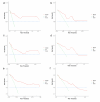Development and validation of an inflammation-nutrition indices-based nomogram for predicting early recurrence in patients with stage IB lung adenocarcinoma
- PMID: 39443648
- PMCID: PMC11500178
- DOI: 10.1038/s41598-024-76230-2
Development and validation of an inflammation-nutrition indices-based nomogram for predicting early recurrence in patients with stage IB lung adenocarcinoma
Abstract
To explore the inflammation-nutrition indices and related clinical factors affecting early recurrence in patients with stage IB LUAD. A retrospective analysis was conducted on clinical and pathological data of patients diagnosed with stage IB LUAD who underwent radical surgery in our hospital from January 2016 to January 2021. Using R software, patients were randomly divided into training (n = 140) and validation (n = 59) cohorts in a 7:3 ratio. Univariate and multivariate Cox regression analyses were performed to identify risk factors for RFS and construct a predictive model. The performance of the model was evaluated using the area under the receiver operating characteristic curve (AUC), concordance index (C-index), and calibration curve. Clinical utility of the model was assessed using decision curve analysis (DCA). Multivariate Cox regression analysis revealed that vascular invasion, visceral pleural invasion, predominant pattern, preoperative NLR > 2.33, preoperative PLR > 127.62, and preoperative PNI ≤ 48.3 were independent risk factors for RFS. The C-index of the nomogram model constructed based on these independent risk factors was 0.825 (95% CI: 0.762-0.881) in the training cohort and 0.772 (95% CI: 0.667-0.876) in the validation cohort. The ROC curves showed AUCs of 0.902, 0.881, and 0.877 for 1-year, 2-year, and 3-year RFS in the training cohort and AUCs of 0.782, 0.825, and 0.732 in the validation cohort respectively. Calibration curve and decision curve analysis indicated good clinical value of the model. The nomogram model based on inflammation-nutrition indices has predictive value for early recurrence in patients with stage IB LUAD.
Keywords: Early recurrence; Inflammation-nutrition indices; Nomogram; Stage IB lung adenocarcinoma.
© 2024. The Author(s).
Conflict of interest statement
The authors declare no competing interests.
Figures





Similar articles
-
Predicting the prognosis of patients with renal cell carcinoma based on the systemic immune inflammation index and prognostic nutritional index.Sci Rep. 2024 Oct 23;14(1):25045. doi: 10.1038/s41598-024-76519-2. Sci Rep. 2024. PMID: 39443568 Free PMC article.
-
Prognostic model for predicting recurrence in hepatocellular carcinoma patients with high systemic immune-inflammation index based on machine learning in a multicenter study.Front Immunol. 2024 Sep 9;15:1459740. doi: 10.3389/fimmu.2024.1459740. eCollection 2024. Front Immunol. 2024. PMID: 39315112 Free PMC article.
-
[Risk factors and nomogram construction for predicting long-term survival in hepatoid adenocarcinoma of the stomach].Zhonghua Wei Chang Wai Ke Za Zhi. 2025 Feb 25;28(2):157-168. doi: 10.3760/cma.j.cn441530-20240910-00312. Zhonghua Wei Chang Wai Ke Za Zhi. 2025. PMID: 39971567 Chinese.
-
Nomograms established for predicting microvascular invasion and early recurrence in patients with small hepatocellular carcinoma.BMC Cancer. 2024 Aug 1;24(1):929. doi: 10.1186/s12885-024-12655-2. BMC Cancer. 2024. PMID: 39090609 Free PMC article.
-
Nomogram for the preoperative prediction of Ki-67 expression and prognosis in stage IA lung adenocarcinoma based on clinical and multi-slice spiral computed tomography features.BMC Med Imaging. 2024 Jun 12;24(1):143. doi: 10.1186/s12880-024-01305-5. BMC Med Imaging. 2024. PMID: 38867154 Free PMC article.
References
-
- Sung, H. et al. Global Cancer statistics 2020: GLOBOCAN estimates of incidence and Mortality Worldwide for 36 cancers in 185 countries. CA Cancer J. Clin.71(3), 209–249. 10.3322/caac.21660 (2021). - PubMed
-
- Herbst, R. S., Morgensztern, D. & Boshoff, C. The biology and management of non-small cell lung cancer. Nature24(7689), 446–454. 10.1038/nature25183 (2018). - PubMed
-
- Goldstraw, P. et al. The IASLC Lung Cancer Staging Project: Proposals for revision of the TNM Stage groupings in the Forthcoming (Eighth) Edition of the TNM classification for Lung Cancer. J. Thorac. Oncol.11(1), 39–51. 10.1016/j.jtho.2015.09.009 (2016). - PubMed
-
- Nicholson, A. G. et al. The 2021 WHO classification of lung tumors: Impact of advances since 2015. J. Thorac. Oncol.17(3), 362–387. 10.1016/j.jtho.2021.11.003 (2022). - PubMed
Publication types
MeSH terms
Grants and funding
LinkOut - more resources
Full Text Sources

